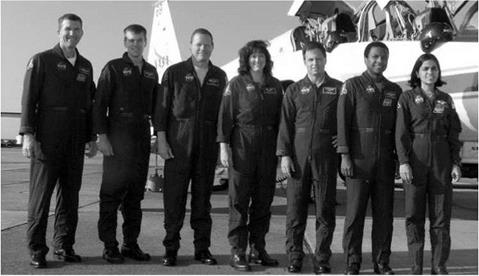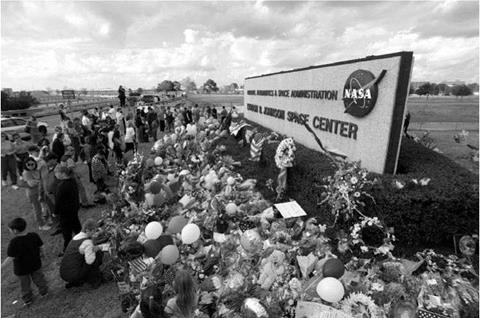Triumph and tragedy
|
“COLUMBIA IS LOST—THERE ARE NO SURVIVORS”
|
STS-107 lifted off at the beginning of a solo Shuttle flight on January 16, 2003. The “Freestar” flight carried a seven-person crew and was designed to appease the critics of the ISS science programme. Columbia, the oldest of NASA’s Shuttle orbiter fleet, had just completed an extensive refit programme and this was her first flight after being returned to operations. The orbiter now carried the Extended Duration Orbiter fuel cell system, which would allow Columbia to remain in orbit for 16 days. STS-107 did not visit ISS, which was in a completely different orbit, and did not carry sufficient propellant to make the manoeuvres to do so, but it would have a major impact on the ISS programme.
One minute after lift-off, one of two bipod ramps, made of shaped insulation foam, was seen to detach itself from the ET, at a point near the bipod holding Columbia’s nose. A white cloud suggested that the foam impacted the underside of the left wing and broke up. With no RMS fitted and no EVA planned, it was not possible for the crew to inspect the underside of the left wing. Although the crew could have made a contingency EVA, they were not cleared to leave the payload bay. As Columbia’s orbit meant that she could not reach ISS, there was no opportunity for the ISS crew to inspect the orbiter for damage. The incident was investigated on the ground in Houston, and it was decided that it would not affect the mission, which
|
Figure 34. The STS-107 solo Shuttle flight crew pose alongside a NASA T-38 jet trainer. They are (L to R): Rick Husband, William McCool, David Brown, Laurel Clark, Ilan Ramon, Michael Anderson, and Kalpana Chawla. Their tragic deaths in the Shuttle orbiter Columbia would ground the remaining three Shuttles and stall the construction of ISS for the next three |
years.
continued as per the flight plan. Despite requests from engineers connected with the flight, NASA managers failed to ask the US Air Force to use its satellites to image the orbiter in space in an attempt to identify any damage. On the subject of the observed impact, Flight Director Steve Stich e-mailed the crew saying, “We have seen this phenomenon on several other flights and there is absolutely no concern for re-entry.”
This was the first flight of the new SpaceHab Double Science Module, which was carried in Columbia’s payload bay. Among the 80 experiments that the crew performed 30 were sponsored by ESA. STS-107 was dedicated to science, with the crew splitting into two groups and working rotating 12-hour shifts in order to maximise their time in space. For 16 days the 7 astronauts performed their experiments largely ignored by the press and media which had been so critical of the lack of such work on ISS.
On January 28, both the STS-107 crew and the ISS Expedition crew joined the rest of NASA in remembering the astronauts lost in the January 27, 1967 Apollo-1 fire and the January 28,1986 STS-51L Challenger explosion. At Cape Canaveral flags flew at half mast at LC-34 and LC-39 for the two days of remembrance.
Columbia’s Commander Rick Husband radioed, before a moment of silence to mark the exact time that STS-51L exploded:
“It is today that we remember and honour the crews of Apollo 1 and Challenger.
They made the ultimate sacrifice, giving their lives and service to their country and
for all mankind… Their dedication and devotion to the exploration of space was an inspiration to each of us and still motivates people around the world to achieve great things and service to others.”
On February 1, their mission behind them, the STS-107 crew strapped into their seats and prepared for re-entry. As they crossed the Indian Ocean Husband turned his spacecraft so that the closed payload bay doors were facing Earth and the three SSMEs were facing the direction of travel. Retrofire occurred at 09: 17, and the hour – long descent to KSC began. Husband turned Columbia through 180°, with the nose forward and pitched up, to present the orbiter’s flat, high-drag underside to the atmosphere for re-entry. Columbia entered the upper atmosphere and crossed the Californian coast at 09:51. As it did so, the telemetry from the hydraulic system on the inboard and outboard elevons on the left wing dropped out. Three minutes later telemetry was lost from the brake lines and tyres on the main undercarriage on the left side. At that time the spacecraft’s computer alerted the crew to the loss of data. Charles Hobaugh, Capcom in Houston radioed, “Columbia, Houston. We see your tyre pressure message.’’ Scanning his instruments Husband acknowledged with a simple, “Roger.”
It was 09 : 59. All communications and data transmissions from Columbia abruptly stopped. Streaking across North America, 61,000 km high and travelling at Mach 18.3 Columbia broke up. STS-107 was 15 minutes away from landing in Florida, where the crew’s families were waiting to watch them return home. Beneath the Shuttle’s flight path people reported a loud sound, like an explosion, or an aircraft breaking the sound barrier. Looking up, they saw trails in the sky as the remains of Columbia passed through the thick lower atmosphere. Debris fell to ground in a long swath covering parts of Texas and Louisiana. Among the debris were human remains. DNA testing would be required to identify the remains of individual crew members.
In Houston, all data relating to the flight was secured, in preparation for the investigation in to the cause of Columbia’s loss. The doors to the control room were locked and all communication with the outside world was stopped. In the VIP viewing area at KSC, NASA personnel escorted the astronauts’ families away from the empty runway where they had been expecting to see Columbia land at 10: 15. The remaining Shuttle fleet was immediately grounded indefinitely. At 10: 30, the Expedition-6 crew were informed that Columbia had been lost during re-entry. NASA organised a press conference to inform the media of what had happened. This was in total contrast to the loss of STS-51L, Challenger, in January 1986 when NASA had adopted a “no comment’’ policy.
President Bush was informed of the tragedy at Camp David. He returned to Washington DC by motorcade because the weather was too bad to allow him to be flown there by helicopter. When he arrived he made a speech to the American People, telling them:
“My fellow Americans, this day has brought terrible news and great sadness to our country. At 9 am this morning mission control in Houston lost contact with our Space Shuttle Columbia. A short time later, debris was seen falling from the skies over Texas. The Columbia is lost; there are no survivors.
On board was a crew of seven: Colonel Rick Husband; Lt Colonel Michael Anderson; Commander Laurel Clark; Captain David Brown; Commander William McCool; Dr. Kalpana Chawla; and Ilan Ramon, a Colonel in the Israeli Air Force. These men and women assumed great risk in the service to all humanity.
In an age when space flight has come to seem almost routine; it is easy to overlook the dangers of travel by rocket, and the difficulties of navigating the fierce outer atmosphere of the Earth. These astronauts knew the dangers, and they faced them willingly, knowing they had a high and noble purpose in life. Because of their courage and daring and idealism, we will miss them all the more.
All Americans today are thinking, as well, of the families of these men and women who have been given this sudden shock and grief. You’re not alone. Our entire nation grieves with you. And those you loved will always have the respect and gratitude of this country. The cause for which they died will continue. Mankind is led into the darkness beyond our world by the inspiration ofdiscovery and longing to understand. Our journey into space will go on.’’
NASA immediately established both internal and external investigation teams while members of the public kept their local police services busy reporting the location of debris and human remains. While public broadcasts were made making clear how every piece of debris was potential evidence and should be handed over to the authorities, some individuals still tried to sell Columbia debris on the Internet. Those people fell foul of the authorities, who were monitoring the Internet for just such attempts. Those arrested potentially faced ten years in gaol and a huge fine if found guilty.
In the seven days following the disaster the press and media had a feeding frenzy. Journalists that had ignored the space programme for years suddenly became experts overnight. Despite President Bush’s speech, there were the usual, predictable, demands for the Shuttle to be scrapped and the human space programme to be cancelled. All of the old complaints about ISS were aired and demands were made for the Expedition-6 crew to be bought home and the station abandoned. Many claimed that the STS-107 crew had been sent to their deaths by a NASA that had cut spending on safety checks to the point that Columbia was a creaking wreck just waiting to fall apart around them. Such charges ignored the 100 plus modifications that had just been made to Columbia during a major re-fit. Much was made of the impact incident during launch, and of Columbia’s age. There was speculation about a computer malfunction that positioned the spacecraft incorrectly for re-entry, impact with a micrometeorite, or a piece of junk from an earlier space launch. With America preparing for a war in Iraq, some Muslim extremists publicly claimed that Allah had struck Columbia down because of the combination of Americans, an Indian, and an Israeli in the crew. They pointed to the fact that some of the debris fell in Palestine, Texas as proof of their claim. Some television channels showed film of Arabs parading in the streets and cheering at America’s loss in several Middle Eastern
|
Figure 35. Following the loss of the crew of STS-107, members of the public placed personal memorials alongside the Johnson Space Centre sign in Houston, Texas. The NASA facility is where the Astronaut Office is located and is where crews do much of their training before flying in space. |
cities. The greater majority of Muslims disassociated themselves from these extremist ideas and expressed their sympathy for the loss of the Shuttle’s crew. Although the flight had been largely ignored by the American media, it had been the focus of much attention in Israel and India, where the public were deeply shocked at the loss of their citizens.
One American television presenter publicly aired his total lack of knowledge of his nation’s space programme when he told his audience in all seriousness, “This is not like Tom Hanks’ film Apollo-13, where they fixed the spacecraft and got home safely. This is real life.’’ Just, for his information, the film Apollo-13 was based on an actual spaceflight. The Apollo-13 spacecraft exploded on the way to the Moon, in April 1970. The crew did not “fix the spacecraft” and only “got home safely’’ because of the professional expertise and personal tenacity of everyone concerned with the flight. The crew consisted of James Lovell, John Swigert, and Fredrick Haise. At the time, Tom Hanks was a schoolboy sitting at home, watching it all on television and pretending to land his plastic model of an Apollo Lunar Module on the lounge carpet. Hanks is an excellent actor, but he has never been selected as an astronaut, at least, not in “real life’’.
As time progressed the hysteria subsided and Columbia left the headlines, temporarily. The search for debris and human remains continued and the official
investigation into what had happened got underway. Meanwhile, there were still three people on ISS.












